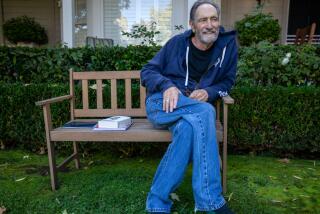Book Review : Rexroth Links Up Life’s Many Facets
- Share via
World Outside the Window: The Selected Essays of Kenneth Rexroth; edited by Bradford Morrow (New Directions: $22.95; 326 pages)
A single essay in “World Outside the Window” will serve to illustrate the extraordinary intellectual inventiveness of the late poet, translator and essayist, Kenneth Rexroth. “The Hasidism of Martin Buber,” first published in 1959, is ostensibly an appreciation of Buber’s “I & Thou,” but Rexroth manages to show us plausible links between Buber’s work and Gnosticism, Existentialism, the Book of Mormon, Kipling, Whitman, the English Hegelians, Sartre, Jung, Weber, the Albigensian Crusade, the Memphis Theology, the Zohar, the New Yorker, T. S. Eliot, Ezra Pound, the Hasidic backwaters of Brooklyn and, astoundingly, jazz.
“It is the ecstatic Hasidic heritage,” Rexroth observes in one of the casual but utterly marvelous cerebral flash points of his prose, “that made it possible for American musicians from Avenue A and Maxwell Street and Williamsburg to meet the Negro half way.”
Rexroth’s genius, as we learn from the generous sampling of work collected here, is to be found in the explosive combination of a self-consciously revolutionary soul and an all-encompassing mind that was literally hot-wired into the whole cultural and spiritual wealth of civilization. (“He read through the encyclopedia each year as a ‘lentative’ (his term) exercise,” explains Bradford Morrow, “lying in the bath with a board laid across the lips of the tub.”) Starting in the grim historical cauldron of the Depression, and reaching across a half-century of politico-poetical tossings and turnings, Rexroth now projects his gifts, his insight and his glorious spirit into history.
“World Outside the Window” is mostly concerned with politics, poetry and religion, but there is literally no nook or cranny of American civilization that goes unobserved or unremarked. At least one theme that runs through these 27 lapidary essays--each one a fitting exemplar of Rexroth’s rock-hard intellect and luminous spirit--is the restless search for authentic values in a debased and degraded civilization.
Veritable Scholar
Rexroth was fascinated by the varieties of human belief--indeed, he was a veritable scholar of religions--and if he is skeptical of orthodoxy, he is also deeply sympathetic to the human craving for truth and meaning: “People have Hanukah lights in the window or Christmas trees at the winter solstice . . . because the society in which they live provides them with no valid life aim and robs them of all conviction of personal integrity,” he wrote. “All ‘neo’ religions are cults of desperation in a time of human self-alienation and social disintegration.”
Rexroth styled himself as an iconoclast, an outsider, but ultimately found himself embraced by a generation of hipsters and then a generation of hippies. His work was published in Playboy as well as the Encyclopedia Britannica. And, by the end of his life, he was hailed as the venerable literary lion of Santa Barbara. But Rexroth was too much the truth-teller to be much impressed by mere respectability, and he intuitively distrusted the “successful” artist.
“The most fashionable artists strive desperately to invent some new nihilism and sell it to idle rich women,” he wrote, with exquisite contempt, of contemporary art. “Meanwhile, throughout the society, millions of mute inglorious people, surfeited with commodities and commodity relationships, become ever more divorced from their work, their fellows, their spouses and children, their lives, and themselves.”
Still, it is art--the art of courage and clear sight--in which Rexroth glimpses the opportunity for redemption. “By the very nature of his art,” Rexroth declares, the true poet “has been an enemy of society . . . and has waged an individual and unaided war.” In D. H. Lawrence, for example, he detects “an act of absolute spiritual transvaluation” which “opens the gates of personal salvation.” And he warns the artist to follow a true calling: “Literature is work. Art is work. And work, said St. Benedict, is prayer,” Rexroth writes. “Be very careful you don’t become what Madison Avenue wants every artist to be--a wild man.”
Within my own library are a very few cherished books to which I return again and again, for comfort as much as wisdom or inspiration--books by Edmund Wilson, Nikos Kazantzakis, Randall Jarrell, Louis Fischer, Alan Watts, J. Bronowski. What these disparate writers share in common is grace of language, depth of both knowledge and insight, a catholic spirit to which “nothing human is alien.” On this bookshelf I have already placed my review copy of “World Outside the Window.”
More to Read
Sign up for our Book Club newsletter
Get the latest news, events and more from the Los Angeles Times Book Club, and help us get L.A. reading and talking.
You may occasionally receive promotional content from the Los Angeles Times.






